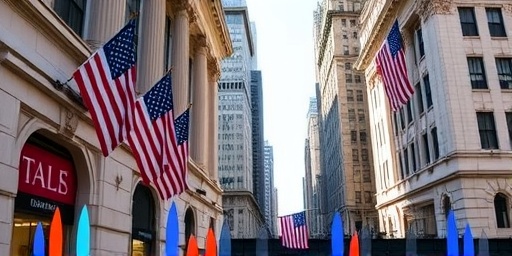In a rollercoaster ride that left traders reeling, Wall Street experienced one of its most volatile weeks in recent memory, with the S&P 500 swinging wildly between gains and losses exceeding 2% daily. This frenzy not only erased over $2 trillion in market value but also laid bare the fragile investor confidence underpinning the U.S. stock market. As finance experts scramble to make sense of the chaos, questions swirl about whether this is a temporary blip or a harbinger of deeper instability.
Tech Giants Drive Initial Market Plunge
The week kicked off with a brutal sell-off in the technology sector, dragging down major indices and amplifying market volatility. On Monday, shares of leading tech firms like Apple and Nvidia tumbled more than 5%, triggered by disappointing earnings reports that revealed slowing growth in artificial intelligence investments. The Nasdaq Composite, heavily weighted toward tech, dropped 3.2% in a single session, marking its worst day since early 2023.
Analysts pointed to overvaluation concerns as a key factor. ‘The stock market has been riding a wave of hype around AI, but reality is catching up,’ said Sarah Jenkins, chief market strategist at Global Finance Advisors. Her comments echoed sentiments across Wall Street, where investor confidence in high-flying tech stocks appeared to shatter overnight. Trading volume surged to 12 billion shares, the highest in months, as panic selling gripped the floor of the New York Stock Exchange.
This downturn wasn’t isolated; it rippled through the broader economy. Consumer electronics retailers saw their stocks decline by an average of 4%, while semiconductor suppliers faced even steeper losses. According to data from Bloomberg, the sector’s market capitalization shrank by $500 billion in just 48 hours, underscoring the interconnected risks in today’s finance landscape.
Fed’s Hawkish Signals Fuel Mid-Week Rally and Reversal
Just as despair set in, a surprise twist from the Federal Reserve injected a dose of optimism into the stock market. Mid-week, Chair Jerome Powell’s comments during a congressional hearing hinted at a potential pause in interest rate hikes, citing cooling inflation data. This sparked a dramatic rebound, with the Dow Jones Industrial Average climbing 1.8% on Wednesday—the largest single-day gain of the year so far.
Investor confidence flickered back to life as bond yields dipped, making equities more attractive. ‘The Fed’s dovish undertone was the lifeline Wall Street needed,’ noted economist Mark Reilly from the Institute for Economic Studies. Finance professionals on trading desks buzzed with activity, with algorithmic trades accounting for 70% of the day’s volume, per reports from Thomson Reuters.
However, the relief was short-lived. By Thursday, fresh economic data showing persistent wage growth reignited fears of sticky inflation, prompting a sharp reversal. The S&P 500 erased all Wednesday gains in a matter of hours, closing down 2.5%. This whipsaw action highlighted the precarious balance in market volatility, where a single policy signal could swing billions in value.
Traders recounted the frenzy in real time on social platforms, with #WallStreetChaos trending globally. One veteran floor trader, speaking anonymously to CNBC, described the scene: ‘It’s like walking a tightrope without a net—investor confidence is paper-thin right now.’
Volatility Index Spikes, Erasing Gains for Retail Investors
The VIX, often dubbed Wall Street’s ‘fear gauge,’ rocketed to 28 points by Friday’s close—its highest level since the 2022 bear market onset. This surge in market volatility wiped out year-to-date gains for many retail investors, who had poured $150 billion into stocks via apps like Robinhood during the bull run.
Finance data from Morningstar revealed that small-cap stocks, popular among individual traders, underperformed by 4% over the week, while hedge funds mitigated losses through sophisticated hedging strategies. ‘Retail investor confidence is the most vulnerable here,’ warned Lisa Chen, a portfolio manager at Vanguard Investments. ‘They lack the tools to navigate this level of volatility.’
Broader implications emerged in consumer behavior surveys. A poll by the Conference Board showed that 40% of Americans now view the stock market as ‘too risky’ for long-term savings, up from 25% a month ago. This erosion of trust could slow capital inflows, further pressuring Wall Street’s recovery efforts.
In historical context, this week’s swings pale compared to the 2008 financial crisis but rival the 2020 pandemic volatility. The CBOE Volatility Index’s average reading of 25 for the period signals heightened uncertainty, prompting institutional investors to shift toward safe-haven assets like Treasury bonds and gold.
Global Ripples and Sector-Specific Fallout
The turbulence on Wall Street didn’t stay contained; it reverberated across global finance markets. European indices like the FTSE 100 fell 1.5% in sympathy, while Asian markets in Tokyo and Shanghai opened lower on Monday. Currency traders watched the U.S. dollar strengthen against the euro by 0.8%, reflecting safe-haven flows amid stock market jitters.
Sector-wise, energy stocks bucked the trend with modest gains, buoyed by rising oil prices to $85 per barrel. Conversely, consumer discretionary names like Tesla and Amazon shed 6-8%, as spending concerns loomed large. Real estate investment trusts (REITs) also suffered, declining 3.7% on fears of higher borrowing costs in a volatile finance environment.
Quotes from industry leaders painted a picture of caution. JPMorgan Chase CEO Jamie Dimon, in a Bloomberg interview, stated, ‘Investor confidence is built on stability, and this week showed how quickly it can unravel.’ Meanwhile, BlackRock’s Larry Fink emphasized diversification, advising clients to brace for prolonged market volatility.
Regulatory scrutiny intensified too. The SEC announced plans to review high-frequency trading practices that exacerbated the week’s swings, aiming to protect retail participants in the stock market ecosystem.
Outlook: Navigating Uncertainty in Finance’s New Normal
As Wall Street dust settles, the path forward remains fraught with challenges. Upcoming jobs data and corporate earnings seasons could either restore investor confidence or deepen the cracks. Finance watchers predict that if market volatility persists above 20 on the VIX, we might see a 10% correction in major indices by quarter’s end.
Experts urge a measured approach. ‘Diversify beyond stocks and monitor Fed cues closely,’ advises Reilly. For policymakers, bolstering market stability through clearer communication is key to rebuilding trust.
In the longer term, this wild week serves as a wake-up call for the U.S. stock market’s resilience. With geopolitical tensions in the Middle East and election-year uncertainties, investor confidence hangs in the balance. Traders are already positioning for next week’s Fed minutes release, which could dictate whether Wall Street stabilizes or spirals further into volatility.
Ultimately, the finance world’s interconnectedness means no corner is immune. As one analyst put it, ‘In times like these, patience and prudence will separate the survivors from the speculators.’









